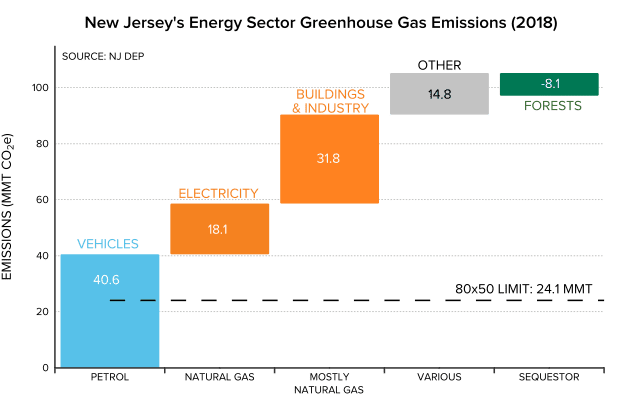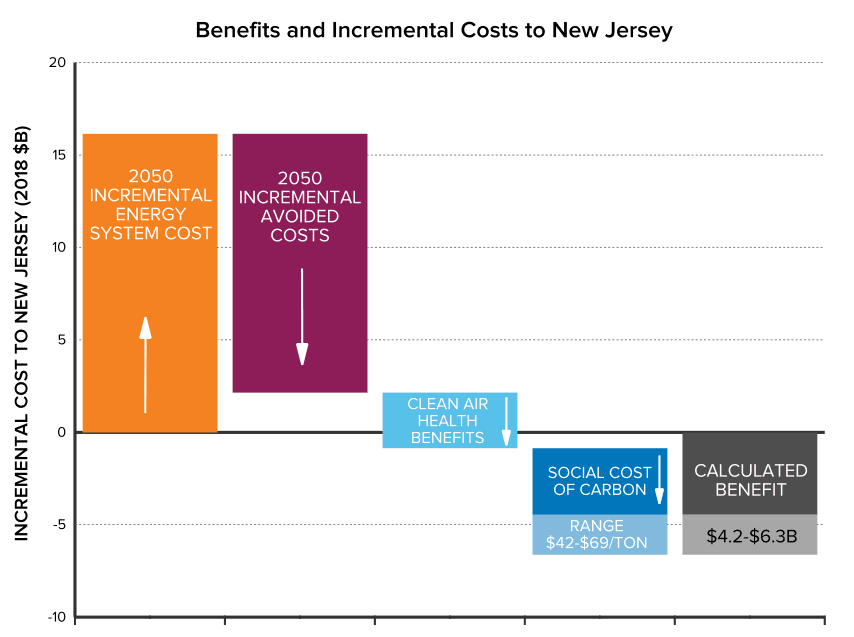
New Jersey Charts a Practical, Affordable Course to a Decarbonized Economy
New Jersey is planning comprehensively for economy-wide decarbonization, and putting meaningful, near-term policies in place to affordably reduce emissions
This week, New Jersey released its 2019 Energy Master Plan (EMP) that shows how the state can take action today to affordably meet its ambitious 2050 clean energy and decarbonization targets. The EMP describes leading-edge policies, supported by analysis from Rocky Mountain Institute (RMI), that start New Jersey on an economic path to reduce its carbon emissions by 80 percent and power its economy with a 100 percent carbon-neutral grid by 2050.
New Jersey has long demonstrated policy leadership intended to promote clean energy and mitigate climate change. In 2007, New Jersey passed the Global Warming Response Act, committing the state to reduce greenhouse gas emissions in 2050 by 80 percent, from 2006 levels. Governor Phil Murphy, upon taking office in 2018, further committed New Jersey to 100 percent clean energy by 2050.
Governor Murphy also asked the New Jersey Board of Public Utilities (NJBPU) to carefully consider the choices New Jersey must confront to justly and cost-effectively meet decarbonization goals. Rocky Mountain Institute, together with Evolved Energy Research, analyzed six decarbonization pathways that New Jersey could take and summarized the findings for policymakers and the public. This week, NJBPU released its Energy Master Plan that includes this RMI analysis and new policy recommendations.
Importantly, RMI’s analysis shows that sensible policy choices, such as those laid out in the EMP, will allow New Jersey to decarbonize affordably, with total economy-wide energy costs similar to business as usual—and with direct health benefits for New Jersey residents and societal carbon benefits that outweigh any differences.
80 Percent by 2050 Decarbonization Requires Changes in all Economic Sectors
As shown in Figure 1 below, transportation, electricity, and buildings must all reduce their emissions considerably for the state to meet its 80 percent by 2050 greenhouse gas reduction targets. Today, on their own, buildings and transportation exceed the 2050 emission targets. Because New Jersey’s economy will continue to grow, policy changes must address these sectors directly, but also take into account how New Jersey’s energy system is coupled—as changes in one sector’s energy system has implications for energy use in other parts of the economy.
Figure 1: New Jersey emissions and target, by sector and fuel.
Electrifying New Jersey’s Economy with Renewable Energy
In both buildings and transportation, there are two primary decarbonization paths. With one path, existing fossil and liquid fuels (mostly natural gas, gasoline, and diesel) are increasingly substituted with low-carbon or carbon-neutral equivalents. In the second path, these sectors electrify, eliminating the need to burn fuels directly in vehicles or buildings. Consistent with work done by RMI and others across the country, RMI’s pathways analysis for NJBPU shows that electrification of buildings and vehicles makes the most sense for New Jersey for the following reasons:
- Electric vehicles (EVs) and building appliances are approximately three times more efficient than fossil-burning equivalents. EVs and heat pumps (for water heating and building space heat) use roughly one-third the energy of gasoline vehicles or natural gas-fired water heaters and furnaces. With this increased efficiency, RMI’s analysis found that New Jersey can save money by needing less energy delivered to customers in the first place. In addition, heat pumps for space heating also serve double duty as air conditioners in the summertime, further reducing appliance costs for New Jersey customers.
- Low-carbon fuels are expensive and/or limited in availability. RMI examined decarbonization scenarios where buildings and vehicles used biofuels or synthetic fuels made with CO2 captured from the atmosphere. We found that these alternative fuels are not competitive today at the scale required to decarbonize direct fuel use, and are likely to stay comparatively expensive. Even optimistic cost trajectories for biofuels remain high. Synthetic fuel is more expensive than electrification because it requires more electricity to create the fuels than it does to simply power electrified end-use devices.
- Electrification is lower risk and provides New Jersey with more options for further decarbonization. The RMI analysis found that retention of end-use fuels would lock New Jersey into a system with very uncertain fuel options in the context of legislatively-required, economy-wide emissions reduction targets. Both biofuels and carbon-neutral synthetic fuels would require a new national market whose future existence is uncertain. With electrification, the state has numerous options for generation, including solar, offshore wind, nuclear, clean regional imports, and synthetic electric fuels (that are more efficient to use in the electricity system than for end uses). Electrified end uses also enable demand flexibility, which can help integrate renewable resources and reduce electricity system costs for New Jersey customers.
- Continuing to burn fuels in buildings and vehicles threatens the health of New Jersey residents, especially the most vulnerable. Burning fossil gas in buildings produces emissions that reduce air quality and endanger human health. Tailpipe emissions from diesel and gasoline-powered vehicles endanger health and are concentrated in environmental justice communities; the American Lung Association in 2016 estimated health benefits for New Jersey of approximately $2.5 billion per year associated with meeting zero-emission vehicle targets.
- Electrification creates quality jobs by replacing out-of-state fuel purchases with investments in New Jersey. Today, New Jersey residents and businesses spends billions each year on natural gas, gasoline, and diesel fuels produced elsewhere. With electrification, New Jersey will reduce those purchases and replace them with local jobs in the building and electricity sectors, including in the growing HVAC, solar, and offshore wind industries.
Growing the Grid and Cutting Carbon
With building and transportation electrification, RMI found that New Jersey’s electricity use will more than double through 2050 (Figure 2), even after meeting and exceeding New Jersey’s nation-leading energy efficiency goals. In-state solar, offshore wind, and clean energy imports from neighboring states can reduce the need for fossil generation and meet growing load. Battery storage, efficiency programs, and demand flexibility (especially for EV charging) can be cost-effective solutions for meeting short electricity demand peaks in the coming decade.
Figure 2: New Jersey electricity generation mix and load, as analyzed in the least-cost decarbonization pathway.
Through the early 2030s, New Jersey will be able to rely on battery storage, existing fossil gas generation capacity, and transmission from neighboring states to preserve reliability, even as load grows and renewables are deployed aggressively. However, as decarbonization proceeds, the state will need to consider new technologies to maintain electricity reliability, especially during periods where wind and solar production are limited for longer periods. RMI analysis found that today’s battery technologies, even with projected cost declines, would be expensive for these periods. However, there are a number of options likely to be available when this need for long-duration balancing of energy arises, including:
- Substituting biogas or carbon-neutral synthetic gas in existing fossil gas generators (biogas was the lowest cost option that was modeled)
- New, long-duration storage technologies, such as flow batteries
- Fuel cells or modified gas turbines fueled by “green hydrogen” created with carbon-neutral electricity
RMI’s analysis found that New Jersey can decarbonize its electricity sector through the 2020s with existing technologies, but there is an opportunity to continue to monitor how these and other emerging technologies mature so that the state can enable appropriate investment in the 2030s.
An Affordable Clean Energy Transition
RMI’s analysis in support of the EMP found that the additional cost of decarbonization is small, and smaller than both direct and indirect benefits associated with reducing fossil fuel use across New Jersey’s economy (Figure 3). As described in Appendix A of the EMP, New Jersey’s energy spending would look much different after clean energy transition. Instead of spending billions on fossil fuels (purple bar in Figure 3), New Jersey would invest in clean energy infrastructure, electric vehicles, and efficient appliances (orange bar) and benefit from cleaner air and reduced carbon emissions (blue bars). In total, RMI analysis suggested between $4.2 and $6.3 billion per year in savings associated with the least-cost decarbonization pathway compared to business as usual.
Figure 3: Incremental costs and direct and indirect savings associated with least-cost decarbonization in New Jersey
New Jersey Is Already Taking Action
Armed with a clear roadmap guiding the state’s path toward decarbonization, New Jersey is already taking important steps to put itself on track to meet its emissions targets.
Last November, Governor Murphy announced the state will increase deployment of offshore wind to 7,500 MW. It has already awarded Ørsted with a 1,100 MW contract. New Jersey’s Board of Public Utilities is revamping its solar programs so that they remain healthy and encourage continued solar growth in the state.
This January, the state legislature passed, and Governor Murphy signed, new legislation to accelerate adoption of EVs. This bill incentivizes new EV purchases, invests in charging infrastructure, and accelerates the electrification of buses.
Finally, the recent Energy Master Plan outlines seven strategies consistent with decarbonization. If, as intended, this plan helps guide new state policies, New Jersey will be well on its way to meeting its 100 percent Clean Energy and 80 percent by 2050 Global Warming Response Act targets.


